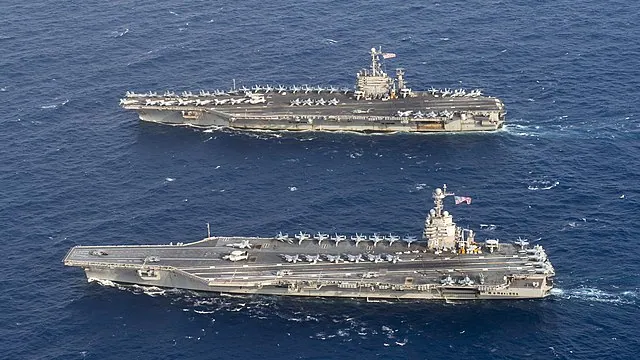Naval power is a cornerstone of military dominance, enabling nations to project force and protect their interests across the globe. Among the many assets comprising a powerful naval force, aircraft carriers stand out as formidable symbols of strength and capability. The United States, with its global reach and robust military presence, boasts a significant fleet of aircraft carriers. In this article, we delve into the question: How many aircraft carriers does the US have? Join us on this exploration of the naval power that the US wields on the world’s oceans.
The Importance of Aircraft Carriers
Aircraft carriers serve as mobile airbases at sea, capable of launching and recovering various types of aircraft. These floating powerhouses enable nations to deploy air power to remote regions, support expeditionary operations, conduct offensive strikes, and provide humanitarian assistance when needed. With their long-range strike capabilities, command and control centers, and ability to project force, aircraft carriers play a pivotal role in modern warfare.

The US Fleet of Aircraft Carriers
According to Naval Vessel Register, the United States operates a fleet of 11 aircraft carriers. These carriers are divided into two primary classes: the Nimitz-class and the newer Ford-class carriers. The Nimitz-class carriers, which have been the backbone of the US carrier fleet for decades, consist of ten carriers. These include USS Nimitz (CVN 68), USS Dwight D. Eisenhower (CVN 69), USS Carl Vinson (CVN 70), and others.
List of the US aircraft carriers in service in 2024
| Ship Name | Entered Service |
| Gerald R. Ford (CVN-78) | 22 July 2017 |
| Nimitz (CVN-68) | 13 May 1975 |
| Dwight D. Eisenhower (CVN-69) | 18 October 1977 |
| Carl Vinson (CVN-70) | 13 March 1982 |
| Theodore Roosevelt (CVN-71) | 25 October 1986 |
| Abraham Lincoln (CVN-72) | 11 November 1989 |
| George Washington (CVN-73) | 4 July 1992 |
| John C. Stennis (CVN-74) | 9 December 1995 |
| Harry S. Truman (CVN-75) | 25 July 1998 |
| Ronald Reagan (CVN-76) | 12 July 2003 |
| George H.W. Bush (CVN-77) | 10 January 2009 |
The Ford-class carriers represent the future of US naval aviation. The first carrier of this class, USS Gerald R. Ford (CVN 78), was commissioned in 2017. These carriers incorporate advanced technologies and enhancements, such as electromagnetic aircraft launch systems (EMALS) and advanced arresting gear (AAG), which improve efficiency and operational capabilities. It is also one of the biggest aircraft carriers in the world.
Gerald R. Ford (CVN-78)
https://www.youtube.com/watch?v=m_z3W89WDH8
Length- 1092ft
Height- 250ft
Beam- 256ft ( flight deck)
Speed- 30 knots
Nimitz (CVN-68)
Length- 1092ft
Height- 244ft
Beam- 252ft ( flight deck)
Speed- 31.5 knots
Dwight D. Eisenhower (CVN-69)
Length- 1092ft
Height- 244ft
Beam- 252ft ( flight deck)
Speed- 30+ knots
What are the future names of the U.S. aircraft carriers?
A total of 10 Gerald R. Ford-class carriers will be added to the US aircraft carrier fleet by 2058. The future aircraft carriers of the US include the USS John F. Kennedy (CVN 79), launched in December 2019 and set to be delivered to the navy in July 2025. The Enterprise and Doris Miller class carriers are anticipated to follow, with expected delivery dates in March 2028 and February 2032, respectively.
Strategic Capabilities and Global Reach
The US aircraft carrier fleet provides the country with an unmatched ability to project power worldwide. These carriers, accompanied by their support ships and carrier strike groups, also form a formidable force that can respond rapidly to crises and conduct sustained operations in any theater of operations. With their embarked air wings, which typically consist of fighter jets, reconnaissance aircraft, and support aircraft, US aircraft carriers are capable of performing a wide range of missions, including air superiority, strike missions, anti-submarine warfare, and humanitarian aid.
Beyond their military capabilities, aircraft carriers also serve as visible symbols of US global presence and commitment to security alliances. Their presence often serves as a deterrent and a reassurance to allies while sending a clear message to potential adversaries.
Summary of ‘How Many Aircraft Carriers Does the US Have?
In conclusion, the United States, with its 11 aircraft carriers, maintains a significant advantage in naval power projection. It is at the top of the list of the most powerful navies in the world. These floating airbases are a vital component of the country’s military strategy, providing unrivaled reach, versatility, and the ability to swiftly respond to global challenges. As the US Navy continues to modernize its fleet with the introduction of the Ford-class carriers, the nation’s naval power will only strengthen further.
In summary, the US aircraft carrier fleet represents a pinnacle of naval engineering and power. It also showcases the nation’s commitment to maintaining its position as a dominant force on the world’s oceans. With its impressive arsenal of aircraft carriers, the United States ensures its ability to project influence, protect its interests, and maintain peace and stability across the globe.
For those excellent officers or soldiers who work hard on the aircraft carrier, we can give them military coins to express our gratitude to them.
FAQs:
Q: What carrier will replace the Nimitz?
A: The Gerald R. Ford-class carriers will replace the Nimitz-class carriers. The last Nimitz-class aircraft carrier will be decommissioned in 2058.
Q: How many Ford carriers are planned?
A: The US aircraft carrier fleet is set to expand with the addition of a total of 10 Gerald R. Ford-class carriers by the year 2058.
Q: Which country has the most aircraft carriers?
A: The United States has the most aircraft carriers. Currently, it operates 11 aircraft carriers.
Q: What is the longest aircraft carrier?
A: The world’s largest aircraft carrier is the USS Gerald R. Ford (CVN 78).
Q: What’s the world’s largest warship?
A: Nuclear supercarrier the USS Gerald R. Ford ( CVN-78) is the world’s largest warship.
Q: What is the largest US aircraft carrier?
A: The USS Gerald R. Ford ( CVN-78) is the largest US aircraft carrier.
Q: How many aircraft carrier strike groups does the US have?
A: The US Navy has 11 carrier strike groups. A Carrier Strike Group (CSG) or Carrier Battle Group (CVBG) typically comprises one Aircraft Carrier, two Guided Missile Cruisers, two Anti-Aircraft Warships, and one to two Anti-Submarine Destroyers or Frigates.
Q: What is the strongest U.S. aircraft carrier?
A: The USS Gerald R. Ford ( CVN-78) is the strongest US aircraft carrier.
Q: Who has the most advanced aircraft carrier?
A: The US Navy has the most advanced aircraft carrier, the USS Gerald R. Ford ( CVN-78).
Q: How many aircraft carriers does the US have in reserve?
A: The US aims to expand its aircraft carrier fleet with 10 Gerald R. Ford-class carriers by 2058. The USS John F. Kennedy (CVN 79) launched in December 2019 and will be delivered in July 2025. Upcoming carriers, Enterprise and Doris Miller class, are projected to be delivered in March 2028 and February 2032, respectively.







